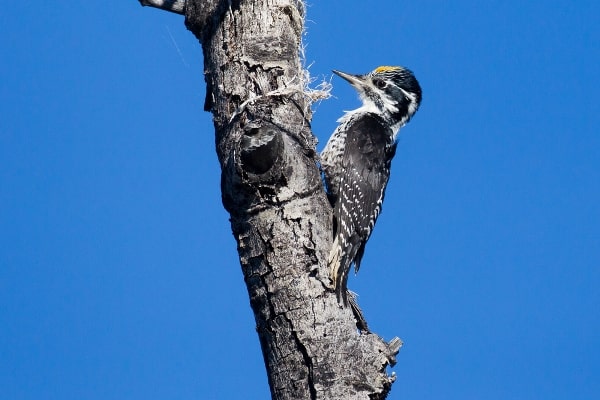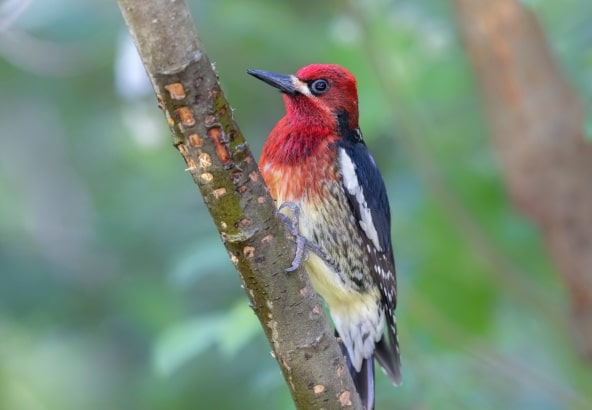Alaska boasts some of the most rugged, wild, and diverse landscapes in all of the United States. Where there are forests (which is much of Alaska) there are woodpeckers.
Birdwatchers in Alaska are spoiled with riches. Not only are there seven species of woodpeckers that you can spot, but there are numerous areas you can head to in order to complete your Life List.
Denali National Park is a sure place for birdwatching, as is Glacier Bay National Park, the Copper River Delta, and even the city of Anchorage. Summer is an easier time to spot woodpeckers in Alaska, but you can find some species there all year long.
You can even book birdwatching tours if you want a guide to help you identify some of the various species in the state. Don’t forget your binoculars!
Here is the list of species of woodpeckers in Alaska:
- Downy Woodpecker
- Hairy Woodpecker
- Yellow-bellied Sapsucker
- American Three-Toed Woodpecker
- Black-backed Woodpecker
- Northern Flicker
- Red-breasted Sapsucker
7 Types of Woodpeckers in Alaska
1. Downy Woodpecker

Scientific name: Dryobates pubescens
Size: 7 inches long
Weight: 0.75-0.99 ounces
Wingspan: 10-12 inches
The downy woodpecker is the smallest woodpecker that you can find in Alaska (and the rest of North America). But don’t worry, its tiny size doesn’t make it difficult to spot. That’s because it’s bold and not too afraid of people. It’s probably the most common woodpecker to see in all of Alaska, so the chances are good that you’ll be able to spot one no matter where you live in the state.
This cute little bird doesn’t migrate. Instead, it stays in its home year-round, which means you can spot these woodpeckers anytime you head outside. While they may change their habitat range during the seasons, they don’t travel too far.
Hang a suet feeder in your yard if you want to be able to see these birds. They’re the most frequent visitor of suet feeders of all the different woodpeckers in Alaska. They also love deadwood, which means that you can spot them in the many recently burned forests in the state.
During the wintertime, they flock with other birds such as chickadees and nuthatches for safety and to find food. They build their nests in the cavity of trees where they live and raise their young. Their nests can be extremely high up in trees.
Downy woodpeckers are black and white, with distinctly spotted wings and a white chest. Adult males have a bright red cap on the back of their heads, which makes them easy to identify from females.
Because of their small size, they can land on small stems of plants to hunt for food. They’re also small enough that they often make nests in the wood siding of homes, much to the dismay of homeowners.
2. Hairy Woodpecker

Scientific name: Picoides villosus
Size: 7.5 inches
Weight: 1.4-3.4 ounces
Wingspan: 13-16 inches
Hairy woodpeckers look similar to downy woodpeckers, but they’re larger. They also have longer bills, which are almost the same length as their head. They’re black and white, and you can tell the genders from one another because the adult males have a little red spot on the back of their heads.
These pretty woodpeckers aren’t as common in Alaska as their cousin, the downy woodpecker, but they’re still pretty easy to find. You can see them in parks, suburban areas, cemeteries, and other quiet wooded or open areas. They also visit suet feeders in suburban backyards.
Like their cousin, the downy woodpecker, hairy woodpeckers don’t migrate during the cold weather and stay in the same place all year. They make their homes in the cavities of dead trees.
Research published in The Journal of Wildlife Management found that they prefer forests that have been recently burned because there is abundant food for them there. Sadly, since Alaska has experienced many wildfires in the past few years, they can be easier to spot in those burned areas rather than in cities.
Populations have been declining in the past decades because they’re losing their habitat. They also face pressure from invasive birds like European starlings, which steal their nesting spots.
3. Yellow-bellied Sapsucker

Scientific name: Sphyrapicus varius
Size: 7.1-8.7 inches
Weight: 1.5-1.9 ounces
Wingspan: 13.4-15.8 inches
These birds are mostly black and white, with white bellies, and black and white barred wings and back. You can tell the difference between males and females because the throat of the male is bright red. Females, on the other hand, have a white throat. Both the females and males have red foreheads.
The females have a faint yellow coloring to their bellies, but it can be so faint that you might not be able to identify it.
The birds drill little holes with their beaks and then they wait for the sweet sap to emerge from the tree. They lick this up, as well as any insects that crawl along and get themselves stuck in the sap.
You might see them hanging out at your backyard suet feeder, but they mostly stick to forested areas. They’re extremely rare in Alaska and have only been identified a few times.
4. American Three-Toed Woodpecker

Scientific name: Picoides dorsalis
Size: 8.3-9.1 inches
Weight: 1.6-2.4 ounces
Wingspan: 14.6-15.3 inches
This woodpecker primarily makes Canada its home, but it also lives year-round in western parts of the country, including Washington, Alaska, Colorado, Arizona and Oregon.
This is the most widespread woodpecker in all of Alaska and you can find it wherever there are spruce forests.
This bird likes to hunt in burned-out areas and forests where beetles have killed lots of trees. It hunts for insects, pulling and stripping away bark until it finds what it is looking for.
Yes, this bird only has three toes, but you’ll most easily be able to identify it by its coloring. It’s primarily black, but it does have white barring on its sides and back, and the chest is white. The male has a bright yellow crown.
If you see these woodpeckers in your Alaska yard, welcome them! They eat destructive beetles that can kill trees.
5. Black-backed Woodpecker

Scientific name: Picoides arcticus
Size: 9.1 inches
Weight: 2.1-3.1 ounces
Wingspan: 15.8-16.5 inches
Many woodpeckers in North America are some pattern of black and white, often with a red patch on the head. This woodpecker stands out because of its solid black back and white chest. It has a black face with a distinct white stripe. The male has a small yellow crown.
Making its home in burned-out forests across Canada and the western US, its black coloring helps it blend in with the charred trees that it hunts on. It eats beetle larvae and will hang out in recently-burned areas for several years before moving onto more newly burned areas.
While this woodpecker lives year-round in Alaska, it’s shy and difficult to spot. It only lives in forested areas and feeds primarily on the trunks of the trees, so you might find it challenging to see them among all the foliage.
6. Northern Flicker

Scientific name: Colaptes auratus
Size: 11-12 inches
Weight: 4-6.5 ounces
Wingspan: 16.5-20 inches
The distinctive Northern Flicker woodpecker lives in open habitats near trees, as well as in parks and cemeteries across Alaska. They are a frequent visitor to suet feeders in suburban and urban yards. Unlike some woodpeckers, they like to hunt around on the ground rather than in the trees.
They’re another one of the most common woodpeckers in Alaska and perhaps the easiest to identify.
The males, females, and juveniles vary in appearance depending on where they live. In Alaska, there are two color variations.
They’re brown in color overall, with black spots. The underside of the wings and tails are yellow in the majority of Alaska and red in the southeast part of the US. Some have a red or black stripe on their cheeks, and many of them have large, black crescents on their chest. Others have red marks on the back of the head. Some have a slightly gray head.
In the spring, you can hear the calls of Northern flickers for a long way off. They have a distinct call, and once you know what it sounds like, it’s easy to tell when they’re nearby.
They primarily eat ants, but they’ll also feast on other insects such as caterpillars, beetles, and termites. They’re definitely a bird you want to have around! There are also instances of them catching young bats as they leave the nest. You can tempt them to visit your home by offering a suet feeder in the yard.
Flickers who live in northern climates like Alaska and Canada will migrate south to places with warmer temperatures during the winter.
Studies show that Northern Flickers can lose their nests to invaders like European starlings. Plus, many humans are trying to deter them because they can make holes in the wood and cavities of homes.
7. Red-Breasted Sapsucker

Scientific name: Sphyrapicus ruber
Size: 7.9-8.7 inches
Weight: 1.9-2.2 ounces
Wingspan: 14.5-16 inches
These woodpeckers live on the west coast of the US, migrating from Canada and Alaska to parts of Northern California in the winter. They’re not easy to see in the state because they’re fairly rare there and don’t live there year-round. You’ll only see them in the southeast part of the state.
They have brush-like tongues that they use to lap up sap that they access by pecking little holes in the wood of trees. They’ll also eat the soft green layer of wood underneath the bark. They also eat berries and fruit and will visit suet feeders.
The adults have a red head and chest, with a black back and mottled grey and black chest. Juveniles lack the red head and chest and have an overall brown hue.
They’re related to Red-naped sapsuckers, and for a while, scientists thought they were the same species. Scientists have determined that these birds prefer old-growth forests and that populations might be reduced as old-growth forests are cut down.
Also Read: Owls in Alaska
